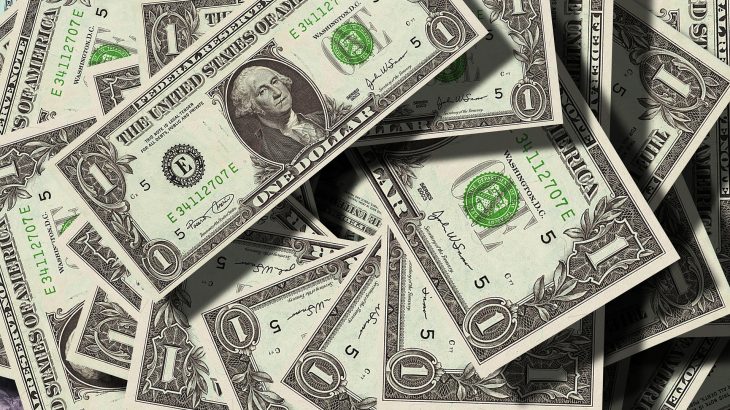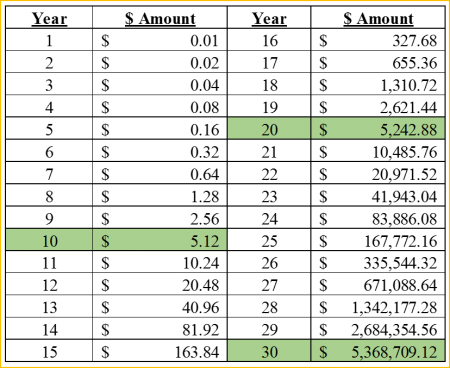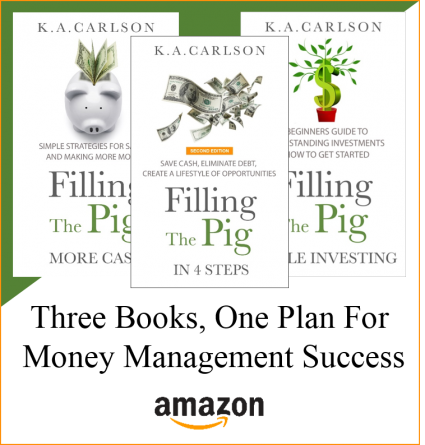It’s probably the single most important mathematical concept to understand about investing. The effect compounding interest or a rate of return has on your money over time. It’s important because it can significantly change your perspective on how much money you invest, where you invest and how soon you should start.
When I was in college attending my first introductory finance class our instructor started the class with the chart below.
The chart above depicts the impact of investing a single penny in year one and then having that penny double (your rate of return) in value each year for 30 years. The idea is that regardless of how small the initial investment, over time even a small amount can eventually lead to a whole bunch of money.
Of course, doubling your money every year isn’t realistic. But the example above is a simple way of showing you what compounding can do for your money.
Related Posts:
- Rule of 72 and Doubling Your Money
- How Much Money Do You Need to Start Investing
- Open a Brokerage Account Online, In 4 Simple Steps
- How to Create Passive Income Through a Dividend Income Strategy
- What is a Dollar-Cost Averaging Investment Strategy
- Understanding Robo-Advisors and Automated Investing Video
What is Compounding?
Quite simply it’s the ability to make money from the money you already made off your investment. An investment is a savings account, CD, IRA, mutual fund – any investment.
For example, if you have $100 in your savings account and are paid an interest rate of 2% by your bank, at the end of year one you would have $102.
In the following year, earning the same interest rate your initial $100 would grow to $104.04. You would earn 2% interest on the initial $100 you deposited and 2% interest on the $2 you earned in the first year. Compounding is earning interest on interest.
The impact compounding has on your money is based on three key variables.
- The interest rate or rate of return you expect to make on your money.
- The amount of time you have to compound that rate.
- How often you can contribute to an investment vehicle.
Real Life Examples – The Effect of Compounding Interest or Rate of Return
The scenarios below depict the impact compounding has on your money based on the rate of return you earn, how much time you have to invest and how consistently you can contribute to an investment.
Scenario 1 – The importance of a higher rate of return.
A one-time $1,000 investment, invested for 30 years in a:
- Savings account earning 2% = $1,811.
- Mutual fund earning 9% = $13,267
As you can see the rate of return on various investment vehicles can have a significant impact on how much money you can make over the course of 30 years. Saving accounts and CD’s are low risks, low return methods of investing. Mutual funds, stocks, and bonds are higher risk, but provide higher rates of return. If you are saving for retirement selecting the right investment with a higher rate of return can significantly impact how much money you will have when you retire. In the scenario above it could be as much as 7 times more.
Scenario 2 – The value of time.
Contributing $1,000 annually in a mutual fund earning 9% for:
- 5 years = $5,984.
- 30 years = $136,307.
The longer you can contribute to an investment the longer compounding has to work. A $1,000 annual contribution is less than $84 per month, the sooner you start investing the longer your money has time to grow.
If you’re looking for a simple way to start investing, I recommend Wealthsimple. Wealthsimple provides automated investing services. You can open a simple savings account, Traditional or Roth IRA or roll-over your existing 401(k). In addition to great service, they also provide a Socially Responsible Investing (SRI) portfolio so you invest in SRI related companies. Signup here to get started.
Scenario 3 – The value of consistency.
A one-time $1,000 investment in a mutual fund earning 9% for 30 years.
- $13,267.
Contributing $1,000 to a mutual fund annually earning 9% for 30 years.
- $136,307
As important as your rate of return and time is to the compounding equation, contributing consistently increases the benefit of compounding. Contributing to an employer 401(k) via payroll deduction, or funding an IRA annually will allow your money to grow 20 times what a one-time contribution will provide.
Related Posts:
Regardless of how you look at the effect of compounding interest, the more time you have and the consistency of your contributions can have a significant effect on how much money you will eventually have. If you’re younger and just starting out in your career the most important thing you can do is start contributing (no matter how small the amount) to some sort of investment vehicle on a consistent basis. Time is on your side. If you’re older, and your time horizon is shorter consider reviewing your investments to match your propensity for risk with a higher rate of return.
Helpful Resources:
- Read more Simple Investing articles here.
- Motley Fool – Stock Advisor
- Wealthsimple – Automated Investing, Open an IRA Account, No Account Minimum
- Personal Capital – All Your Financial Tools in One Place
- 3 Steps to Start Investing email course, sign-up it’s free.
What do you invest in to maximize and compound? Comment below.
Sign up for a Kindle Unlimited 30 Day Free Trial and read the complete Filling The Pig finance series of books for free.



